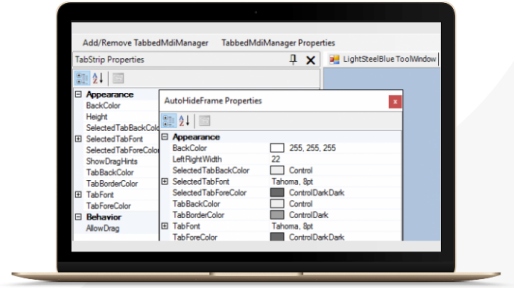Give your Windows Forms apps the ability to dock and float windows, make panels that auto-hide, group windows into tabs, and more.

Give your Windows Forms apps the ability to dock and float windows, make panels that auto-hide, group windows into tabs, and more. Feature rich, and easy to use. Backed by a responsive support team.
- Easy set-up
- Saves and loads window layouts
- Data-binding friendly

Dock and float windows, make windows auto-hide, and group windows into tabs. Recreates the functionality and the look of Visual Studio’s docking windows interface. The containers let us use any .NET control with them.
Provides a logical and intuitive object model, and full programmatic control of all end-user interface features.
Features:
. NET technology
- Written entirely in managed C# code. Source code provided with Blueprint Subscription.
- Includes VB.NET and C# samples for Visual Studio.
- Object-oriented design created exclusively for .NET Windows Forms development.
- Comprehensive documentation fully integrated into Visual Studio.
- All error handling works through .NET exception classes.
- CLS compliant (Common Language Specification).
- Does not use unsafe blocks to minimize security risks.
- Integrates well into dashboard and business intelligence software.
Major features
- Create windows that can be docked, floated, or tab-grouped, as needed.
- Smooth auto-hide feature lets you keep windows conveniently out of the way.
- Exact look and behavior of the Visual Studio docking windows interface.
- Full programmatic control of all end-user interface features.
- Supports MDI applications.
- Supports tabbed MDI. Right-click on a tab brings up all the expected options (float, dock, auto hide, hide). Control-tab displays the expected pop-up window with the list of control-tab destinations.
Additional features
- Undock an entire group of windows at once into a floating tab-group.
- Dock a window into a floating window, not just the main window.
- Vertical or horizontal tabs for auto-hidden windows, depending on location.
- Pin and unpin windows to enable or disable auto-hide.
- Drag a tab to undock a tab-grouped window.
- Docked windows are proportionately resized with the main form.
- Data-binding friendly: the application’s DataContext is propagated to each window.
- Save and load window layouts.
- Assign icons to tabs.
- Set the speed with which auto-hide ToolWindows are shown or displayed.
- Set the delay before auto-hide ToolWindows are shown or hidden.
- Create any number of window groups, horizontally or vertically tabbed.
- Set the width and height of auto-hide tabs, as well as the height of group tabs.
- Change the appearance of the selected tab.
- Windows reliably remember their last position when being restored.
- Double-click title bar to toggle between docked and floating state.
- Change appearance of group tabs, auto-hide frames, captions, and title bars.
- Design contents of windows as if they were a User Control.
- Windows can be easily created directly from User Controls.
- Windows can contain any .NET control.
- Prevent the end-user from changing window states, such as going from floating to docking, etc.
- Specify a work area around which windows can dock or group.

